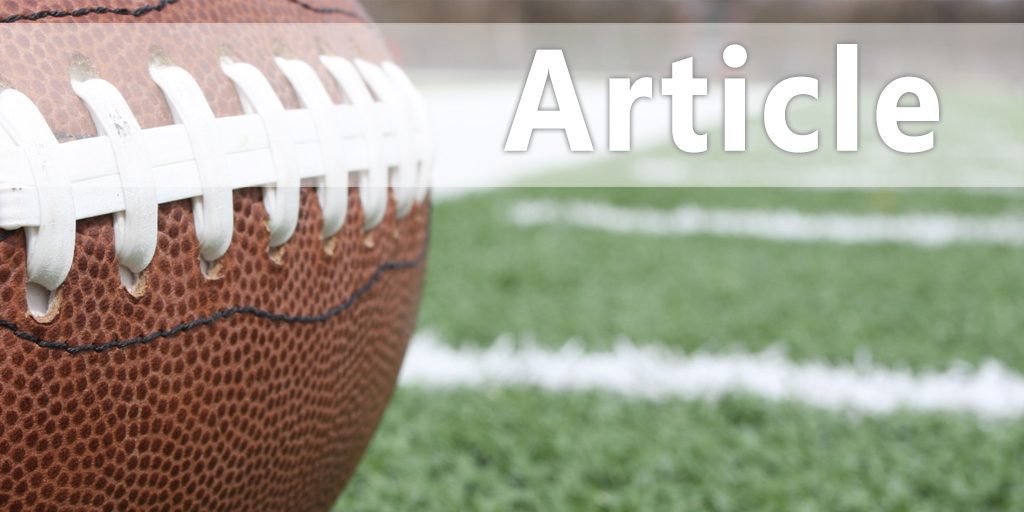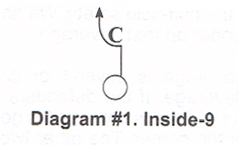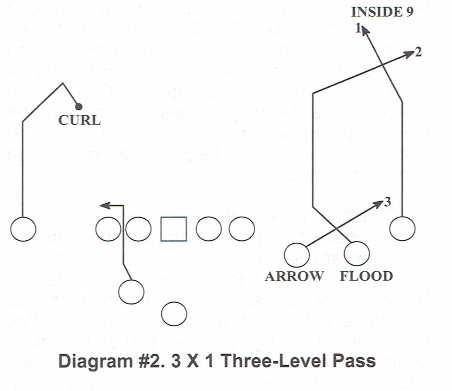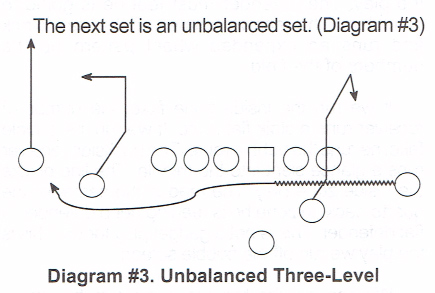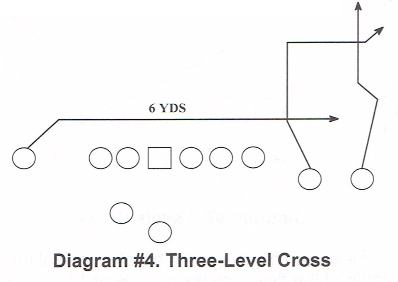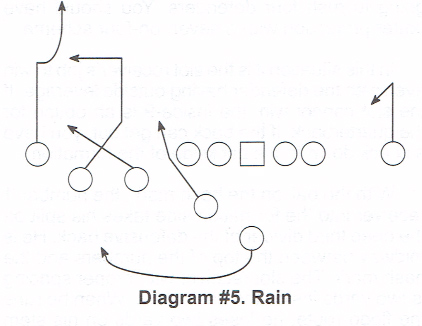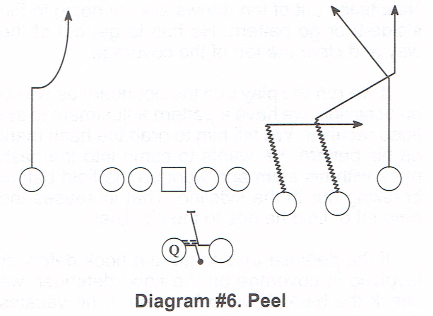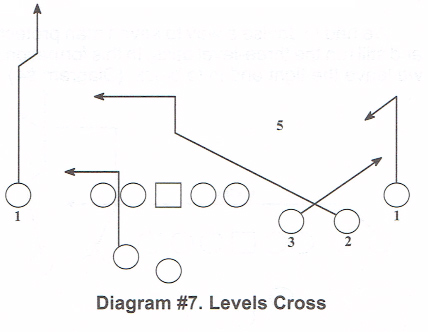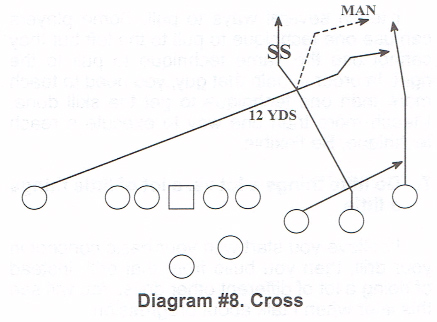| Blueprint to Winning and Three-Level Passing Game |
| By: Tom Herman - Univ. of Houston
Originally Published in: Nike 2016 Coach of the Year Clinics Football Manual - Earl Browning Provided by: Nike Coach of the Year These last 13 months have been a whirlwind for me. I went from winning a National Championship at Ohio State to taking over the football program at Houston. When I went Houston I felt we had to change the culture of the program. I am going to talk about that first, and some X's and O's, which I will get into later. We went into Houston and had a great season and followed that up with a great recruiting class. It finally feels like the activity has started to settle down and we can pause and take a deep breath. It is nice to be able to do that with my family. This time last year, they were in Columbus and I was in Houston. I did not see much of them. Now I am getting a chance to coach little league baseball and to play with my two-and-half-year-old son. Speaking of my wife, we were the Grand Marshals at the Mardi-Gras parade in Galveston. We were driving back and I finally had time to reflect with my wife about all the things that had gone on in our lives over the past 13 months. We won the National Championship at Ohio State. We won the American Athletic Conference Championship, going 13-1 for the season. Then we won a New Year's Day Bowl game against a perennial power in Florida State. And we signed a top 30 recruiting class. That last fact is unheard of for a school at our level. I was born in Ohio but grew up in California. I was a D-III football player. My first coaching job was at Texas Lutheran College. I made $5,000 a year, and a meal card at the cafeteria. My wife stayed in California because she had a job. She supported me in Texas. She was my sugar mama. She got a job coming out of college, and I hopped in my Honda Civic and drove from California to Seguin, Texas. I took the job sight unseen. I became a graduate assistant at the University of Texas and got my first full time position at Sam Houston State. I spent four years there as wide receivers coach and special-team's coordinator. I got a big break and became the offensive coordinator at Texas State. I spent seven years in coaching and did not make over forty thousand dollars a year until I was 31 years old. I have two undergraduate degrees and a master's degree. We were reminiscing about the hard times while we were driving up 1-45. We were telling each other how much we appreciated each other. I asked her in her wildest dreams when we started off like we did, did she ever think we would be in the position we are in today. She looked me dead in the eye and said, "Tom, you are not in my wildest dreams." That was a long story to get to what they call an icebreaker. I love clinics. In fact, the other day, we had one in Texas right up the road. I did not like that clinic because they discouraged you from asking questions. I want you to ask any questions that comes up during this talk. 1 certainly do not have all the answers, but I will do the best I can to answer anything you want to know. Like an Urban Meyer disciple, at Houston we start out with our core values. Core Values: • Honesty • Treat women with respect • No drugs • No stealing • No weapons • Difference between a mistake and a core value These core values never change. We are open and honest within our program. The difference between a core value and a mistake in our program has to do with correct-ability. If a player misses a class, we can correct that. We can teach, discipline, and teach the player how to correct mistakes. If a player has a problem with those five core values, I am not equipped as a coach to solve those problems. If a player puts his hands on a woman in a violent manner, I do not know how to fix the player. I do not know how to fix that player and he is out of our program. I do not have a psychology degree. I do not know how to fix liars. I am not a drug counselor and do not know how to solve drug addiction. Our core values define who the player is as a human being. We all make mistakes. I make them and so do the players I coach. We can correct and educate those players on how not to make those mistakes again. At the end of the day, if the player is in violation of our core values, it is serious and in all likelihood, he will be removed from our football team. Program Philosophy: • Act like a man, be treated like a man • Academically ° Blue, Red, Gold ° Each player is put into a color group which will dictate how he is treated ° Placement is determined by the student athlete's work ethics and ability • Socially ° Zero tolerance for violation of core values • Everyone puts in the same amount of work ° Any excused or unexcused workout missed will be made up, there will be no deviation from this policy ° The "Pit" area is designated for injured players, this will enforce the policy that each player will commit to the same effort and investment whether they practice or are unable to practice. ° When I was a graduate assistant at Texas, Mack Brown said something that I never will forget. He said, "Fair does not mean equal." Being treated fair in our program means that you earn the way you are treated. That could be good or bad. That does not mean the good players are treated differently than the others. It means if you act like a man, we treat you like a man. In our academic program, when a player joins our program he is at the blue level or we say a child. Your classes are constantly checked, you have eight hours of study hall a week, and you cannot move off campus. You are a child and must be monitored constantly. You can graduate to the red and gold groups, but we have some juniors and seniors that are still in the blue group. They have not figured how to grow up and be treated like a man. If you graduate to the red group, the rules relax somewhat. You are allowed to miss a class here and there. You only have six hours of study hall a week. You are allowed to move off campus if you chose. The gold group are the players that take care of business. We do not check their classes and do not come to study hall unless they choose to come. They can have tutors if they choose but none of that is a mandate. Once you graduate from one group and move to the next does not mean you will stay there. If you screw up, you can go from a red group back to a blue group. If you were living in an apartment, you have to move back to the dorm. We are hard on our players and the privileges they get, they earn. Everyone does the same amount of work. We do not have a democracy. We have a meritocracy. That means the players get what they earn or merit. Not everyone gets the same stuff in our program, but everyone will put in the same amount of work. How you go about doing the work, will determine what your merit is to the team. If you miss a workout or practice, that is fine with us. However, you will make that workout up at 6:00 a.m. the next day. It does not matter whether the excuse is a good one, you are going to do the same amount of work. It is the same way with an injured player. If he is injured, he goes to the "Pit." You do not want to be in the "Pit." It is not punishment for being injured. It keeps players from wishing they were injured. In some programs the injured players are on the side sipping water and watching. We take our injured players, separate them from the team, and they work on a moderate program related to their injury. They work harder than the player in practice. Our purpose in our program is to train to win every day in everything we do. I want to get on my soap box a minute. We are raising a generation of people that accept mediocrity. They are the kids that accept average and just showing up is okay. That is not the way I was raised and not the way I believe. We train to win in everything we do every single day. I do not want this to sound like winners always get the corner office, big house, fancy car, and the hot wife and losers do not. Winning is not about material things. It is about being the best you can be, and competition is part of that process. Compete against the guys who are considered to be the best at what they do. Compete against your own best self. Football is the last bastion in society, where players understand the value of competition and winning. It is the last place where if a player gives his best every day, good things will happen. It does not depend on his talent level; it only depends on him doing the best he can. How Do We Achieve Our Purpose? • Develop a culture on this team of toughness and accountability • Enhance the grind • Follow the blueprint...it is infallible We beat four or five teams this year that had better talent than us. We beat Louisville, Cincinnati, Temple, Florida State, and Vanderbilt. Cincinnati had four wide receivers drafted. They have a left tackle that will go in the first round and a returning quarterback that will be in the draft next year. Florida State would not trade one of their 22 starters for any of our players. Vanderbilt had a top twenty defense. Louisville. had far more talent on the field than we did. Temple had seven first team choices on the all-conference team. We played them in the conference championship and beat them. We won 13 games this year and the one we lost, we should have won. We screwed it up. How do you do those things? You do it by being mentally and physically tough. We train that aspect of the game every day. Our players take pride in it. Last spring practice, we had 550 reps of live tackling, where we took the ball carrier to the ground. The year before, they did that 120 times. We convince our players that our training camp is the hardest camp in all of football. We believe that and they do too. We embrace that fact. We are proud of how tough and hardened it makes us as a team. To go along with the toughness, you must have accountability. That is a cool way to say love. We use the word love in our program more than any other program in America. When I do something for myself, if it gets hard, it is easy to quit and go on to something else. No one else is depending on me to get the job done. That is alright because the only person I am hurting and letting down is myself. However, when you truly love someone and they are counting on you to do your job, it is impossible as a human being to give up. That is the type of relationships we wanted to build within our team. We dive into their lives more than any other coaching staff in the country. We know their girlfriend's name, we know all their families, what their class schedule is, and everything about them. The way we treat and feel about our team is by design. In our program we spell love T 1 M E. We spend an inordinate amount of time with our players. Our players love their position coaches. It is a genuine love. I think men loving men is a lost value in our society. It is the brotherly love I am referring to. We love our teammates and will do anything for them. We are accountable to them. We must as a team follow the "blueprint." The only thing that can screw up the blueprint is people. That not only includes teammates, but coaches, academic advisors. or anyone involved with the team. The decisions and choices you make as a person is a choice. It will affect someone. We teach that in our program. We must be exceptionally clear about our expectations with regard to the culture of Houston football. When it comes to our culture there can be zero confusion. The following is a blueprint that lays out our culture with clarity and simplicity. These are our standards. This is how we are and this is our identity. HOUSTON FOOTBALL CULTURE BLUEPRINT What we Believe we Achieve: • MENTALITY ° How We Behave - Compete in everything you do, in class, in the community, and on the field of battle. ° What We Achieve - We will compete longer and harder than any situation or opponent that we face. "Win the Day" be 1-0. • COMPETETIVE FOCUS ° How We Behave - Constant focus on mental reps and game reps. ° What We Achieve - You are prepared to make the play when your number is called. • SMALL UNIT COHESION ° How We Behave - Uncommon Commitment to each other and the work necessary to achieve our purpose. Trust your unit leader do not let your brothers down. ° What We Achieve - Brotherhood of trust. Combat Motivation. There is zero confusion in our program. Anyone that touches our player's lives is aligned with the same message. The players get bombarded each day with different messages. The four hour a day we have them during season, I want the same message delivered by everyone associated with that player. Within our meeting rooms we have the same message on the walls. To succeed you must compete. For us, every second of every day is a competition. There are three main components that you must compete against. The first one is the easiest to get motivated to do. That is personal competition against another player. The other two are really hard. The second one is to compete against your own best self. We talk about that all the time. They must compete against themselves every day. When I lay my head on the pillow each night, I will have accomplished three things during that day. I will be a better husband, better father, and better head football coach. If I am not better during those 16 hours I was up because of some decision I made, or some action I took during the day, than why did I bother getting up. The last component is that demon inside of you; your conscience. That little voice inside of you that tells you it is alright to hit snooze on the alarm or turn your paper in late. It is the voice that tells you it is okay to do nine reps on the bench press instead of ten. We are fallen creatures. That is human nature. It is easier to take the easy way or the convenient way. It is human nature to do what is painless and self-serving. We have to turn that around and teach our players to do what is painful, hard, and not self-serving. Our program is based on two principles. Those principles are honesty and accountability? Honesty: For any organization to function that involves reliance on other members, there has to be an understanding that whatever is said is the truth. There cannot and will not be any keeping of information that can have an effect on the organization and there will be no untruth be said within the organization. Mistakes will be made, however, immediate notification (to the position or the head coach) is expected. At Ohio State and at Houston, we are brutally honest with our players. If it is not good, we tell them. On the other side, if they do a good job we praise them. We consider this team to be a family. If one of the family members does something that effects them all, we have a family meeting and talk about it. If we have a player test positive for drugs, we tell the rest of the team. If a player is lazy, we tell the rest of the team, that he is lazy. If they want him to be a productive part of the team, they need to teach him how not to be lazy. Do not reflect on the negatives. Accent the positives and make that behavior worthy of praise. When you bring the problems of the team in front of the family, things will change because of the love within the family. If they do not change, that means the player does not care about the family. It is important in families to cultivate trust and honesty. Accountability: Each member of this organization (players, coaches, and support staff) has a very clear succinct job description. It is the individual's responsibility to complete the job description to the best of his ability and at the same effort that is expected of all members. The success will be a direct result of the accountability demonstrated by the individual in this program. 5 C's Accountability • Character - share the core values of the team • Competent - has the mental and physical ability to get the job done • Consistent - every play, every day • Committed - without question • Cohesive - first team mentality This could be the 5 C's of teaching. When you have character, your heart is in the right place. Consistent is a great trait of a good teacher. He is the same coach every day he is on the field. Cohesive means the team is more important than any individual. That means team before player. Before we get to the good stuff, I want to talk about discipline. Discipline: • Is 90-percent anticipation • Discipline is ° Doing what you are supposed to do ° When you are supposed to do it ° How you are supposed to do it ° And the intensity to be successful Discipline is 90-percent anticipation. What does that mean? The coach has to know his players. If the team has an off week during the season, the coach has to know his players. The offensive line coach has 17 players he is responsible for. Does he have to worry about all of them? The answer is, "Hell no! But he better be aware of the players he does have to worry about." He better be texting them, calling them, or bringing them to his house for dinner. He must know which players have certain issues. He must plan ahead so he can avoid something happening that requires discipline. Program Objectives: • Win in the classroom and win on the field. • Plan to win ° Play great defense ° Take care of the football ° Score and prevent scores in the red zone ° Great special teams Every program has objectives and I believe this. It was reinforced by my four years with Urban Meyer. We do not have goals about the stats in the game. I do not want to know how many times we rushed the ball. We want to win the game. We went into our last game of the season against Navy. The winner of that game went to the conference championship game. Navy was rushing for 350 yards a game. They threw the ball for 336 yards on us that day. I was never so happy to see a team throw for that many yards. They rushed the ball for 120 yards that day. We held them to 200 yards below their rushing average. We won the game. The stats in a game do not matter a hell of a lot, except a few of them which we keep maliciously. In the 21 games where Navy attempted 20 or more passes, their record was 0-21. We decided if they can beat us by throwing the ball, I would go across the field and congratulate Coach Niumatalor6 and tell him good luck in the championship game. We forced them to throw and won the game. If our defensive goal had anything to do with stats we would not have been successful in that game. However, we won the game and that is one of our program goals. To win you must play great defense. That is not restricted to the defensive side of the ball. The offense has a lot to do with that theory. If they do not turn the ball over and punt it every time, you can play great defense. I have yet to hear a coach at the end of a championship game, tell the media that we won because we out-finessed them. They say they won because they out hit them and were tougher on both sides of the ball. That is the game we play. That is football. You do not win the game with a 100 play offense. You win championships with great defense. Look at the national championship game. Look at the Super Bowl. Look at football at any level and you will find great defenses in the championship games. The offense must take care of the ball. The quarterback cannot take risks. Keep your penalties to a minimum. Running backs have to hang onto the ball and protect it. You must play great special teams. Make the opponent go the long field to score. When our offense takes the field, our goal is to get two first downs before we have to punt the ball. If you do that and punt the ball every time, you will change the field position and help your defense. Winning the turnover margin is tremendously important in winning the game. This year we were third in the turnover margin and first in take-a-ways in the country. When you take the ball away, it leads to more possessions, shorter fields, and more scores. Our defense returned five interceptions for touchdowns and had two safeties. You must score and prevent scores in the red zone. Teams are good at getting in the red zone, but your defense must make them kick field goals. Coach Mason at Vanderbilt said that was tremendously important. When we played them we had to try four field goals in the red zone and made three of them. We do not want to kick field goals in the red zone. When we get inside the 30-yard line we are going for the first down many times. There is a four-point difference in touchdowns and field goals. I do not want to kick a field goal when I have a chance to pick up the first down. The last thing is great special teams play. That is the battle for field position. If you constantly start drives inside the ten and twenty yard lines, your chances of scoring are not good. We want to give the offense the long field at every opportunity. There is no such thing as luck. Winning is a result of preparation, attitude and confidence. There is a difference in a winning attitude versus a losing attitude. Winning Attitude: Even when you lose, you firmly believe you ran out of time. You expect to win and you know eventually you will win. Losing Attitude: Even when you are winning, you expect something bad to happen. There is a lack of confidence and trust in your teammates and coaches. An average player can become a GREAT player with fundamentals. You must work on fundamentals daily. However, there are some factors you must consider. There are reasons why fundamentals DO NOT improve in certain players. Often times the player resists being coached. Too many times the player will not work at the tempo required to improve. One reason is sometimes the player does not possess the innate athletic ability (often an excuse). If he does not improve it is because of not enough repetition or poor teaching. Coaches have to work on their relationships with their players. If done correctly, it can be the most rewarding and closest relationship that you can develop, second only to your family. Relationships are a result of experiences that you share with an individual or individuals. Just the nature of College Football and all the effort, dedication and sacrifice involved puts you and your teammates and coaches in situations that many fail to ever experience. How you handle adversity, success, and the reliance placed on each other to be successful are the determining factors involved in developing relationships. Not many people get the opportunity to develop a relationship that will last a lifetime. Take advantage of it and do it the right way. Surviving adversity requires each team member to be able to overcome the "what if" factor by answering the following: • Are you physically fit? • Are you mentally in the right place? • Are you emotionally in the right place? • Are you spiritually fit? Only a POSITIVE answer to all 4 will prepare you to survive any challenge you face. I have lot more on philosophy but I am going to skip that and get into some football. Are there any questions about our philosophy that you want to ask? Let me tell you we are a run first offense. We may be in the shotgun and no-huddle, but we are a two back run first team. We do it from the shotgun so the defense has to defend the quarterback-run as well. What we want to do is run, run, run, and throw it over your head. If the defense will not let us run or throw it over their heads, we go to the quick passing game on the perimeter. That is who we are and that is what we believe in. We finished 12tr' in the country at rushing the football. We were not a great passing team but our quarterback was one of two in the country to throw for over 2500 yards and rush for over 1000 yards. The other quarterback that did that played in the national championship game for Clemson. The "flood" for us is a three-level passing game. In a three-level pass, you have a receiver deep. one in the intermediate area, and one in the short zone. You can get into those areas in a number of ways, which I will get into later. There are some key components of this pass. Since we are a spread running team, we see many quarter coverage schemes in the secondary. It is basically a cover-1 with the defense trying to get the safeties into their run fits at the line of scrimmage. The first thing we look for is what we call an "inside-9." I learned this from Urban Meyer and it is one of the greatest gifts he gave me. This is not a post route. The "inside-9" will get open against any coverage except cover-2. In a cover-2, it will draw the deep defender. If the receiver gets press coverage from the secondary, he runs a go route and is a viable option for the quarterback. It does not matter what coverage it is. If he gets the press, he is running a go route and is running the pattern to beat the press defender. If the corner plays off the receiver, the receiver attacks the corners outside hand as he runs up the field. (Diagram #1) We tell the receiver to attack the defender and step on his toes.
There is no depth to the route. He is attacking and getting deep. We tell the receiver that the depth of the route is when he can smell the defenders breath and see his acne. The receiver attacks the corners outside hand and runs through his inside hand. We cannot give the receiver exact answers to the receiver questions about angles and depth. We tell him to run at the outside hand of the defender wherever it may be, plant, and run through his inside hand wherever that may be. If the receiver runs through the inside hand of a cover-3 corner, the corner has to turn and latch onto the receiver. That gives the receiver horizontal separation as well as vertical separation If the corner if playing off coverage and squats, the receiver is going to attack through the inside hand and look for the ball. He is going to get the ball. The quarterback will throw the ball and the receiver has to adjust to the throw. Against a "cloud" corner, the receiver gets the best release he can on the corner. Usually it is two steps to the outside shoulder and run a skinny route to the inside. The safety will be on the hash and the receiver wants to get inside the corner and run to the outside hand of the safety. That accounts for the safety, keeps him out of the outside third, and leaves the coverage with one flat defender. We want to get a vertical and horizontal stretch on the flat defender. The inside-9 route may look like different routes at times. The route depends on the play of the corner as to what the route looks like. In each coverage, the receiver reads what the defense does and that determines how he runs the route. The quarterback's read is very simple. That is why we lump all the things I am going to show you into what we call a three-level pass. The only thing the quarterback reads is the deep defender to the flat defender. In cover-4, the deep defender is the quarters safety. If he is flat-footed, we are going long over his head. If he is retreating, we cannot throw the inside-9 so quarterback's eyes go to the flat defender. We have to decide whether the corner is honoring the inside-9. If not, we are going to win with that pattern. In cover-2, the deep defender is the half-field safety. We have to read the flat defender on that coverage. If the coverage is cover-1 or cover-0, we talk about leverage. If the defenders are inside leverage, the wide receiver runs his go route and tries to beat the corner. The other two receivers are running out breaking routes and can run away from the inside leverage defenders. If the coverage is outside leverage man-coverage, the quarterback is going backside to the split end. That is the only time he is going to the backside on this pass. This year we ran a curl on the backside, but in the past we have run a glance post or skinny post. From a 3 X 1 formation, the number-1 receiver runs the inside-9 pattern. (Diagram #2) The flood receiver or the number-2 receiver runs the flood route. The breaking point for that pattern is 10-12 yards. The depth of the pattern varies from defense to defense. We tell them to be equidistant between the deep defender and flat defender.
He wants to be in the middle, in front of the deep defender and behind the flat defender. Usually that depth is around the 18 to 22-yard area on the field. The number-3 receiver runs the arrow route to the flat. It is a true arrow route. He does not release up the field. He goes directly to the flat. He picks a spot on the sideline at three yards and runs straight to it. We have seen flat defenders that play this pattern really good. They play halfway between the flood and arrow patterns and react to the ball well. To help us with that scenario, the flood receiver stems his route two yards to the inside before he starts up the field. That gives us a horizontal stretch defender. The flood receiver runs up the field, sells the post, and breaks outside at 10-12 yards. There are many presentations you can use to run this play. In the unbalanced look we are blocking seven-man protection with the back running a check down pattern after his blocking assignment. We had some problems with our offensive line this year. We had nine different starting lineups in 14 games. At one point for a four game stretch, we had a red-shirt freshman playing left guard, a true freshman playing center, and a true freshman playing right guard. The right guard was a defensive lineman up until the fourth week of the season. Basically we stunk. It was all smoke and mirrors up front and our offensive line coach did a fantastic job getting those guys ready. One thing we must improve on this year is running the inside-9. It is a go route straight up the field moving from the outside to the inside through the defensive back's hands. It is not a post. The next set is an unbalanced set. (Diagram #3)
The outside receiver runs the inside-9 and the slot receiver runs the flood route. The arrow route comes from the motion back coming across the formation. The back in motion does not get down field, but he continues on his motion route and becomes a target for the quarterback. His pattern is more of a flare instead of the arrow route. We had to devise a way to seven man protect and still run the three-level pass. In this formation, we leave the tight end in to block. (Diagram #4)
The number-1 receiver from the backside becomes the arrow route on this three-level pass. The outside receiver runs the inside-9 and the slot receiver runs the intermediate route. The number-1 receiver from the backside runs a shallow cross at a depth no deeper than six yards. The quarterback has the same read. He reads from deep defender to flat defender. When we are coming off our goal line we want to take some shots with this pattern. One of our strengths this year was our slot receivers. If the defense plays an outside man-coverage we do not have a backside throw because of our protection scheme. We want to protect with seven so the tight end has to stay in to block. That gives you an advantage because the defense using outside leverage man-coverage, is only going to rush four defenders. You should have better protection with a seven-on-four scheme. In this situation it is the slot receiver's job to win even with the defender having outside leverage. If the slot cannot win, the inside-9 is an option for the quarterback. If the back can get out, you have a check down to the backside of the formation. With the ball on the hash mark, the number-1 receiver into the formation side takes his split on the deep third divider of the defensive back. He is midway between the top of the numbers and the hash mark. The slot receiver with proper spacing is two yards inside the hash mark. When he runs the flood route, he loses two yards on his stem to the inside of his original alignment. He breaks vertical up the field to 10-12 yards, plants, and runs away to the sidelines working for the middle of the deep and flat defenders. Against press coverage, the number-1 receiver is clearing the area for the flood route. It does not matter if it is inside or outside leverage. He has to get off the line of scrimmage and run a go route. He cannot spend any time at the line trying to get off a defensive back. If the defensive back aligns to his inside and jumps to his outside, the receiver takes his best release and gets up the field. He has to get deep and clear the deep coverage out of the play. Nine times out of ten throws are not going to the inside-9 or go pattern. He has to get out of the way and clear the top of the coverage. If we run the play into the boundary as we do on occasion, we have a pattern adjustment to the flood receiver. We tell him to grab the hash mark on his pattern. He wants to come into the hash mark with his stem and work up the field before breaking out to the sideline. That increases the amount of field he has to the sidelines. If the defense tries to get the hook defender involved in coverage on the flood defender, we check the back down in his area. If he vacates the area, we drop the ball to the running back. The quarterback takes a three-step drop. He has his mind made up early on the inside-9. If he is going to go deep, the ball comes out on his third step. He takes a hitch step and throws to the flood-corner and two hitches to the flat route. We have a cute little play we call "Rain." (Diagram #5)
We run this from a 3 X 1 formation to the field. This is a gift play from the defense. The number-1 receiver to the boundary runs a lock-hitch pattern. That means he runs a six-yard hitch pattern regardless of what type of coverage he has. The quarterback takes the gift hitch, if the defense gives it to him. To the formation we run the flood pattern on the three receiver side. If the hitch is covered, the quarterback pumps the hitch pattern and rolls to the formation side on a sprint out pass. He throws the flood route. The quick game pass becomes a naked bootleg to the field. We run what we call "peel." (Diagram #6) This is a play action pass off the inside zone play.
We run many bubble screens off the inside zone fake. We use this as an answer to the defenses aggressive play on the bubble screen. The number-1 receiver runs a clear out post to the inside at the deep defender. The number-2 receiver runs a stalk wheel pattern. He is stalking the linebacker or strong safety in that area. He wants to make contact with the defender to sell the play. The defender must feel he is going to block him. The receiver comes off the stalk block and runs an expanded wheel pattern up the numbers of the field. If we run the inside zone fake, the number-3 receiver runs a stalk flat route. If we run the bubble fake, he runs the bubble route. The backside receiver runs a glance slant into the middle. The line blocks the inside zone play. The read is the same for the quarterback. In zone he is reading deep defender to flat defender. This is not a gadget play for us. This is the play we run off the bubble screen. We can run the three-level pass to the single receiver side. (Diagram #7) We call it a levels pattern. The number-1 receiver to the single receiver side runs the inside-9 pattern on the deep defender. The number-2 receiver to the formation side is the flood receiver to the backside. We call the cross pattern "levels." He wants to stem his route inside for four yards at a forty-five-degree angle.
If it is man coverage, he breaks vertical up the middle of the field, breaks outside at 10-12 yards, and runs away from the man coverage. If the coverage is zone coverage, he works four yards inside across the field, and gets into the void area in the middle of the deep and flat defenders to the play side. The back in the backfield is the arrow route runner to the play side. I do not like to do that because he has a linebacker check as part of his protection scheme. It is possible to lose the flat pattern on this play. Your flood pattern becomes a two level pattern, which is no good. The numbers-1 and 3 receivers run a curl/flat combination to the backside of the play. We use this play to attack the 3-buzz to the field. The defense uses the strong safety to buzz down to take the arrow route and let the flat defender play the flood. They spin the boundary safety into the middle of the field. This puts the backside flat defenders in a bind. The Will linebacker is along trying to secure the backside of the play. We use the four yard inside stem by the number-2 receiver to give the quarter safety the wrong read. He goes under the Sam linebacker as he stems inside. If the number-2 receiver releases up the field, the safety reads that as a vertical pattern and locks onto the receiver. When the safety sees the receiver go inside and across, he reads that as a drag and his eyes go to the number-1 receiver. By stemming inside for four yards we fool the cover-4 safety. The number-2 receiver on his level pattern wants to stair-step up the field to get to the proper depth in the middle of the deep and flat defenders. If it is man coverage, he needs to make a vertical move up the field before he breaks to the opposite sideline. In a zone coverage, he finds his depth without having to get vertical immediately. He can work his way over to his area gradually gaining depth. When we bring a receiver from the backside to be the intermediate receiver to the play side, he has to be a sprinter. (Diagram #8) The outside receiver to the play side runs his inside-9 at the corner to his side. The number-2 receiver is a dead receiver. He is not part of the progression. He decoys the near safety by running a drive post pattern. He wants to drive at the safety's inside hand and drive him deep.
If the coverage is quarters, the pattern looks like a seam route. If there is a safety in the middle of the field, as in cover-3 or cover-1, the pattern looks like a post. We tell the split end running the cross, because of the distances he has to go, he has to sprint hard to the field to get into his position. He does not take a release up the field. He goes immediately across the field. He wants to sprint hard until he gets to a position of 12-yards deep over the opposite offensive tackle. When he gets to the position over the opposite tackle 12-yards deep, he can determine what kind of coverage he is facing. If it is zone coverage, he continues his pattern and gets between the deep and flat defenders. If it is a man-coverage, he works his stair-step path up the field and breaks to the sideline at the appropriate time. He must win on his route. He cannot be covered because there is no backside throw. All the quarterback has to know is where the deep and flat defenders are in their coverage. It is the same read with flood, peel, levels, or cross. He has the same read every time. Someone will be deep, someone will be in the intermediate area, and someone will be in the flat. That is all he has to know. That is my talk. Our door is always open. We do not have a particular high school day where you can come visit. We had 1,000 high school coaches come through our doors before we even started spring ball. Any day of the week, call and let us know you are coming and we will open the door for you. You can sit in our meetings, watch video, come to practice, and have time with our staff. If there is no practice that day, the mornings are yours to watch video. The afternoon is set aside for visitation with our coaches. We understand we are only as good as the players we can recruit. We also understand the players become who they are through the efforts of their coaches. Before I stop I want to get on the soapbox one more time. I am the only child of a single mom. My dad was never part of my life and the main influence and male figure in my life was my high school football coach. My high school coach taught me how to tie a tie, how to shave, let me borrow his car, and anything a father does. He was the role model in my life. I am sure if you asked a psychologist that is why I am coaching today. We value coaches and what you do. We value your ideas as well. Thank you, I hope to see some of you at our place. Best of luck to you. |
